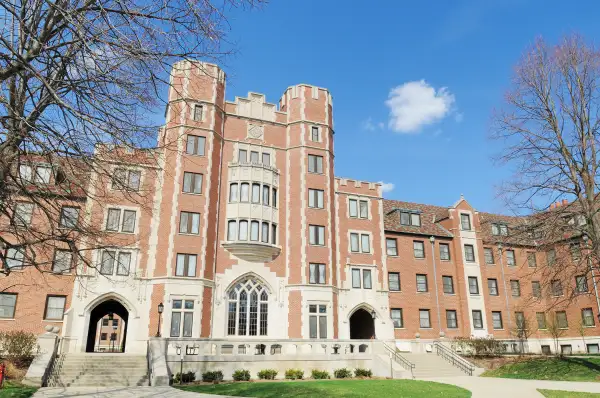Now You Can Sell Shares in Yourself to Pay for College

Taking out another high-interest private student loan seemed like the only option for Amy Wroblewski this fall. The 21-year-old native of Lafayette, Ind., was working two part-time jobs and had maxed out her federal student loans. But she still needed about $13,000 more to fund her junior year at Purdue University.
Then, she and her father happened to be watching a local news show that mentioned Purdue’s test of a different way to pay tuition. The Purdue Research Foundation’s new “Back a Boiler" program would fund upperclassmen who were willing to repay the foundation a percentage of their post-graduation salaries for no more than 10 years.
Her father, who was a cosigner on her private loans, “was super-adamant” that she explore the option, Wroblewski recalls. She did, and became an enthusiastic participant in the nation’s largest ongoing experiment in what are sometimes called “Income Share Agreements” or ISAs.
“I felt such a relief that I didn’t have to go through the process with Sallie Mae, and my parents didn’t have to stress about it,” Wroblewski says. “I think it is an amazing idea.”
In fact, this new way to pay for education is gaining attention from a growing number of colleges, investors, fans - and critics - nationwide.
In 2009, the U.S. Department of Education took a baby step towards ISAs by allowing students to cap their payments on their federal student loans at, typically, 10% of their income, in a program called variously “income-based” or “income-driven” debt repayment.
But the new experiments by Purdue and at least five other organizations represent a more radical idea. Instead of lending money to students, "investors" essentially buy a “share” in a student's future for a limited period of time. If the student makes little or no money in that time, the investors lose out, and the student is free from obligation. If the student succeeds, the investors profit—and the student may pay more than he or she would have on a loan. In other words, students can now sell a kind of stock in themselves.
Allowing students to collect money for college now in return for a share of their after-graduation income is an idea that has a long history and many names. In 1955, libertarian economist Milton Friedman proposed allowing students to sell “human capital investments." (He also acknowledged that some critics might call it “partial slavery.”) Several coding academies offer what they called “deferred tuition.” And several states have passed legislation to study “Pay It Forward” proposals for what would essentially be a graduate tax: Students wouldn’t pay tuition upfront, but instead would pay an extra few percentages of their income.
Fans of ISAs hope these experiments will help solve the growing college affordability crisis.
Alexander Holt, policy analyst for New America, a left-leaning Washington, D.C. think tank, who has studied ISAs, notes that they have received support from across the political spectrum. Purdue’s program was started by the university president, Mitch Daniels, who had previously been a Republican governor of Indiana. The Pay It Forward plans have been promoted by groups such as the Economic Opportunity Institute, a progressive nonprofit in Seattle. “ISAs don’t follow normal partisan lines,” Holt says. “They have the potential to be ‘purple'”—supported by both “red” and “blue" factions.
The new ISA ventures also provide students protection against some of the "partial slavery" concerns. Most of the new ISAs cap payments, for example. Students only have to pay the percentage for anywhere from six months to 10 years, depending on the investor, the size of the investment, and the rate the students are willing to pay. Many ISA programs also set ceilings on the payments. Purdue grads who strike it rich during their repayment period never pay more than 2.5 times the amount they received. And most set minimum earnings requirements for payments. Purdue grads earning less than $20,000 a year have their payments set at $0.
The upsides
Holt and other supporters believe ISAs offer four main advantages:
Reducing students’ risks. If students like Wroblewski take time off to attend graduate school or start a family, or they get sick, or they just can’t find a job, the principal won’t keep growing the way a loan does. In Wroblewski’s case, once she’s made 100 payments of 4.3% of her income, she’ll be free and clear.
Lowering college funding costs. Scholarships and low-interest federal student loans are still the best financial aid for students, Holt notes. But if that's not enough, ISAs can fill in those gaps at a cost that, for many students, will end up being more affordable than high-interest private loans, Holt says.
Enabling low- and moderate-income students to afford college. ISAs are a simple way to allow students who have no money for college to get the education they need to thrive as adults, says Wroblewski. "It's a really great plan for students who don't have financial backing," she says."If more colleges had this, more kids would be inclined to go to college."
Aligning colleges’ incentives with those of their students: Traditional colleges, which get their tuition money up front, are focused on attracting freshmen and keeping students satisfied while in school. If, instead, colleges got some or all of their revenue only if their graduates succeeded, they’d focus on longer-term goals such as making sure their students leave with the skills they need. “We are much more motivated than a regular college,” says Julien Barbier, a co-founder of Holberton School, which is an unaccredited two-year software training progam that charges 17% of students’ income for 3-1/2 years. "If our students fail, we don’t get paid and we die. And we should die.”
For all those advantages, however, ISAs have struggled for more than 60 years for good reason, say critics like Thomas Harnisch, director of state relations and policy analysis for the American Association of State Colleges and Universities.
The downsides
Upfront costs. Colleges need money today to pay professors, electricity bills, and the like, notes Harnisch. So they’d need a lot of funding to pay to educate students who won’t start paying back tuition for at least four and a half years. Those upfront cost concerns appear to have stymied states’ Pay It Forward proposals, he says.
Time. Traditional colleges and investors issuing ISAs to freshmen won’t know whether they’ll even get all their money back for at least seven to 10 years, notes Miguel Palacios, a Vanderbilt professor who cofounded Lumni, a company that creates ISAs, mostly in Latin America. Few investors or colleges have the time or patience to risk money now for a very uncertain return in a decade, he notes. “It’s a classic problem for innovators. If you fail, you bear the costs alone. If the idea flies, there will be lots of competitors. There is a reduced incentive for anyone to go first.”
Collections. Getting graduates to document their income and keep making payments that meet the terms of the contract can be a challenge. Lumni has found “there is definitely some gaming by some repayers” Palacios observes.
Privatizing a social good. Equitable access to higher education helps every citizen, not just those who take college courses, notes Harnisch. Some of the ISA proposals could lead states to further reduce - or even stop - subsidies of public higher education. The AASCU argues that since colleges help all taxpayers, all taxpayers should contribute towards their upkeep, he said.
Incentivizing profit over civic needs. Although there is at least one program offering ISAs for educators, the biggest growth in ISA programs so far has been among short-term coding academies that give college graduates a few months of computer programming training and help them land high-paying tech jobs. Many critics like Harnisch worry that funders won’t want to take risks on students pursuing important but low-paying careers such as teaching, or on women and minorities, who tend to earn less.
So far, the few programs old enough to start collecting payments provide both hope and warning. Andrew Davis, founder of Education Equity Inc., says his first test—funding teachers attending principal-training programs—is starting to recoup its costs. Kush Patel, founder of App Academy, says the bootcamp has found no statistical difference between the earnings and payback of female and male students. In addition, he said some liberal arts majors - especially philosophy, math and history - tend to outperform the computer science majors.
But strictly speaking, the bottom line hasn’t turned black yet for one of the first experimenters with a version of ISAs, Clarkson University in Potsdam, N.Y. In 2010, Clarkson offered freshman Matthew Turcotte four years of free tuition—at the time worth as much as $150,000—in return for 10% of a web design business he had started in high school. While he’s very grateful to Clarkson and is now on the board of the school's entrepreneur center, Turcotte jokes that “I get some tissues and cry a little” when he has to write out the check each year. Last spring, the check was for about $12,000, he said. At that rate, the school will have to wait many years to recoup its costs.
Clarkson's president, Anthony Collins, says the school has continued to offer the same deal to one or two student entrepreneurs each year because the program has many benefits outside of a strict accounting. “It provides a financial and intellectual return. These students enrich classroom discussion,” he says. It's also made Clarkson attractive to entrepreneurial students of all types, including many who don’t win the scholarship. And it catches the attention of potential donors, he notes.
Besides, Collins adds, you never know when one of the entrepreneurs will strike it rich. One of the current crop of Clarkson “Young Entrepreneurs” recently appeared on Shark Tank.
